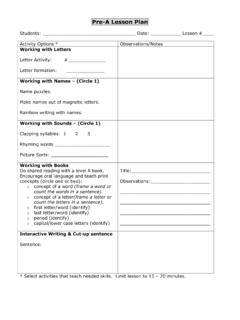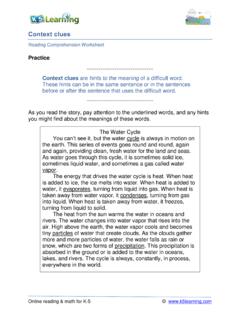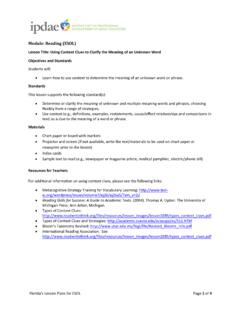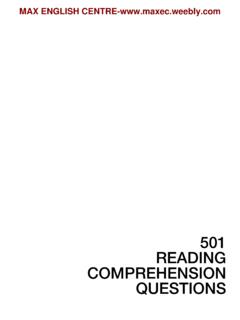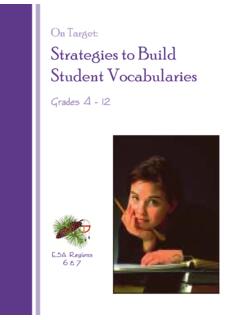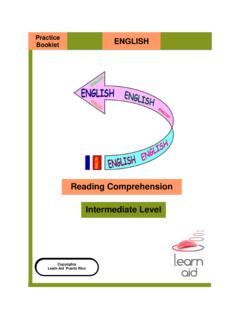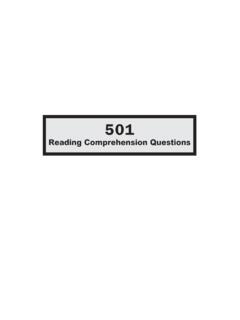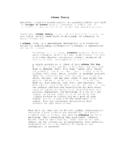Transcription of Pre-A Lesson Plan - Guided Reading 101
1 Pre-A Lesson Plan Students: _____ Date: _____ Lesson #____. Activity Options * Observations/Notes Working with Letters Letter Activity: #_____. Letter formation: _____. Working with Names (Circle 1). Name puzzles. Make names out of magnetic letters. Rainbow writing with names. Working with Sounds (Circle 1). Clapping syllables: 1 2 3. Rhyming words _____. Picture Sorts: _____. Working with Books Do shared Reading with a level A book. Title:_____. Encourage oral language and teach print concepts (circle one or two): Observations:_____. o concept of a word (frame a word or count the words in a sentence). _____. o concept of a letter(frame a letter or count the letters in a sentence). _____. o first letter/word (identify). o last letter/word (identify) _____. o period (identify). o capital/lower case letters (identify) _____. Interactive Writing & Cut-up sentence Sentence: * Select activities that teach needed skills. Limit Lesson to 15 20 minutes.
2 Emergent Guided Reading Lesson Plan Levels A-C; DRA 1-4. Title: _____ Level:____ Group #_____ Lesson #____. Day 1 Date: Day 2 Date: Sight word review-writing: Sight word review-writing _____ _____ _____ _____ _____ _____. Introduce New Book: This book is called _____ Reread Yesterday's Book: Observations and it's about_____. _____. _____. New vocabulary: _____. Text Reading with prompting: Get your mouth ready.. Does that make sense? Check the picture.. Does that sound right and look right? . Show me the word _____. (for sight words). Teaching Points after Reading : Teaching Points after Reading : One-to-one matching (Discourage pointing @ One-to-one matching (Discourage level C.) pointing @ level C.). Using picture clues (Meaning) Using picture clues (Meaning). Monitoring with known words Monitoring with known words Getting mouth ready Getting mouth ready st st Crosschecking picture & 1 letter (always do Crosschecking picture & 1 letter with levels A & B).
3 Discussion Prompt (if appropriate) Discussion Prompt (if appropriate): Teach 1 Sight Word:_____ Teach Same Sight Word:_____. What's missing? What's missing? Mix & Fix Mix & Fix Table writing Table writing Writing on a whiteboard Writing on a whiteboard Guided Writing: Dictated or open- Word Study (Pick only 1): ended sentence Sound sorts:_____. Making words: _____. Sound boxes: _____. Early Guided Reading Lesson Plan Levels D-I; DRA 5-16. Title: _____ Level: ____ Group: #____ Lesson #_____. DAY 1 Date: _____ DAY 2 Date: _____. Sight word review-writing (optional after 8/E) Sight word review-writing _____ _____ _____ _____ _____ _____. Introduce New Book: This book is Reread Yesterday's Book: (NOTES). called___ and it's about_____. _____. _____. _____. _____. New vocabulary: _____. _____. Prompts for Early Readers: (Use for Day 1 and Day 2). Check the picture and think what would make sense. Does it look right and make sense? Reread the sentence.
4 Check the end (or middle) of the word. What would look right and make sense? Cover the ending. Is there a part you know? Try that again. What would make sense? Chunk the word and think what makes sense. Do you know another word that looks like this one? What can you try? What can you do to help yourself? Select one or two teaching points after Reading . Word-solving strategies: comprehension : Self-monitor w/M, S &V Recall information. Reread at difficulty. Retell. Attend to endings. Make predictions. Use known parts. Other: _____. Contractions. Use analogies. Chunk big words. Discussion Prompt: Discussion Prompt: Teach 1 Sight Word: (optional after level E) Teach 1 Sight Word: What's missing? Mix & Fix Table Writing White Board Word Study: Guided Writing: Sound sorts: _____ Levels D-E: Dictate two sentences Level E- F: Beginning-Middle-End (3 sentences). Level G-H: BME (4-5 sentences). Making words: _____ Level G-I: Somebody, Wanted, But, So (SWBS).
5 _____. Sound boxes: _____. Analogy Chart: _____. Transitional Guided Reading Lesson Plan For students Reading at levels J-P who need to improve decoding, fluency and retell. Title:_____ Level: ___ Group: ____Strategy Focus:_____ Lesson #____. Day 1 Date_____ Pages_____ Day 2 Date_____ Pages_____. Introduce New Book: This book is about (Continue first Reading ) Notes/Observations _____ _____. _____ _____. _____. _____. _____. New vocabulary: _____. _____ _____. _____ _____. _____ _____. Teaching Points: Choose 1 or 2 each day Teaching Points: Choose 1 or 2 each day Decoding strategies: Fluency & Phrasing Reread & think what would make sense. Phrasing. Cover (or attend to) the ending. Attend to bold words. Use analogies. Dialogue, intonation & expression. Chunk big words. Vocabulary Strategies comprehension : (oral). Reread the sentence and look for clues. B-M-E 5-finger Retell Check the picture. SWBS Describe a character's feelings Use a known part.
6 Other:_____. Discussion Prompt: Discussion Prompt: Word Study (if appropriate) Word Study (if appropriate). Sound boxes Analogy chart Sound boxes Analogy chart Make a big word Make a big word Day 3 Reread the book for fluency (5-10 min.) & Guided Writing (10-15 min.). Beginning-Middle-End Five-finger retell SWBS Character Analysis Problem solution Compare or contrast Other: _____. _____. _____. _____. _____. Fluent Guided Reading Lesson Plan Title:_____Level:___ Strategy Focus: _____Group:_____. Day 1 Date: _____. Before Reading (5 minutes) Read & Respond (10 minutes) After Reading (5 minutes). This book is about _____ Model Strategy (Comp. or Voc.) Discussion and teaching points _____ _____ _____. _____ _____. _____ _____. _____ _____. _____. _____ _____. _____. Preview & predict (the entire book): _____. _____ _____ _____. _____ Observations & Scaffolds _____. New Vocabulary for Day 1: _____ _____. _____ _____. p. ___ _____.
7 _____. p. ___ _____. _____ Words for the New Word List: p. ___ _____ _____ p. ___ _____. _____. p. ___ _____. Day 2 Date: _____. Before Reading (3 minutes) Read & Respond (12 minutes) After Reading (5 minutes). Preview new text portion: Observations & Scaffolds Discussion and teaching points Today you will read to find out _____ _____. _____ _____ _____. _____ _____. _____. _____ _____. _____. _____ _____. _____. _____ _____ _____. New Vocabulary for Day 2: _____. _____. p. ___ _____ _____. _____ Words for the New Word List: p. ___ _____. _____ p. ___ _____ _____. p. ___ _____ _____ p. ___ _____ _____. Possible Teaching Points for Transitional and Fluent Levels (J+) See handbook for more ideas. Decoding Vocabulary comprehension - fiction comprehension - nonfiction Reread & sound 1st Use context clues STP STP (Stop-Think-Paraphrase). part & make sense Use pictures or VIP Fact-Question Attend to endings visualize Retell story (5 finger) Summarize w/key words Use known parts Use a known part Visualize Main Idea/Details Contractions Make connections to Predict & support Important/Interesting Use analogies known words Make connections Interpreting visual information (maps, charts).
8 Chunk big words Character traits Ask questions Ask questions Contrast or Compare Summarize by chapter Cause/Effect Make inferences Evaluate- fact/opinion, author's point of view (from dialogue, action, Figurative language: _____. or physical description Other:_____. Lesson Plan for Transitional/Fluent Guided Reading back side Day 3 Date: _____. Before Reading (3 min.) Read & Respond (12 minutes) After Reading (5 minutes). Preview the new portion of text Observations & Scaffolds Discussion and teaching points Today you will read to find out _____ _____. _____ _____ _____. _____ _____ _____. _____ _____ _____. _____ _____. _____. _____ _____. _____ _____ _____. New Vocabulary for Day 3 _____. _____. p. __ _____ _____ Words for the New Word List: p. __ _____ _____ p. __ _____ _____ p. __ _____ _____. Day 4 Date: _____(Not every Guided Reading book will take four days to read; some will take longer.). Before Reading (3 min.) Read & Respond (12 minutes) After Reading (5 minutes).)
9 Preview the new portion of text Observations & Scaffolds Discussion and teaching points Today you will read to find out _____ _____. _____ _____ _____. _____ _____ _____. _____ _____. _____. _____ _____. _____ _____. _____. _____ _____. _____. New Vocabulary for Day 4 _____ Words for the New Word List: p. __ _____ _____ p. __ _____ _____ p. __ _____ _____. p. __ _____ _____. Optional Guided Writing (If appropriate): After students finish Reading the book, help them expand their understanding of the text by writing with the teacher's support for 20 minutes. Recommended for struggling writers. _____. _____. _____. _____. Options for Fiction Texts Options for Nonfiction Texts Options for Poetry Retelling (BME or 5 finger). Biography Character analysis, bio poem, Connections text to self, text Event/Detail- from the Beginning, compare/contrast, Event/Contribution to to text, text to world. Middle and End. society. Microthemes Explain one Problem/Solution.
10 Descriptive Text Key idea poem, key theme of the poem. Character Analysis (trait example) idea summary, main idea/details, chapter Literal/figurative meaning. combine with BME to show how summary. (This is what the poem says;. character changes in the story. Only Historical Text Cause/Effect (2 This is what the poem means.). works with dynamic characters. paragraphs), Key idea poem, key idea Explain the meaning of some Microtheme Write a paragraph summary, important event/details, chapter aspect of figurative language. about a message (theme) in the book. summary. Interpreting author's bias: Why Alternate ending Scientific Text compare/contrast (2 did the poet write this poem? Summarize one chapter paragraphs), main idea/details, chapter Other: summary, cause/effect. _____. 10-Minute Guided Reading Lesson for Levels A-I. This plan can be used when you have an emergent or early reader who does not fit into one of your Reading groups.
